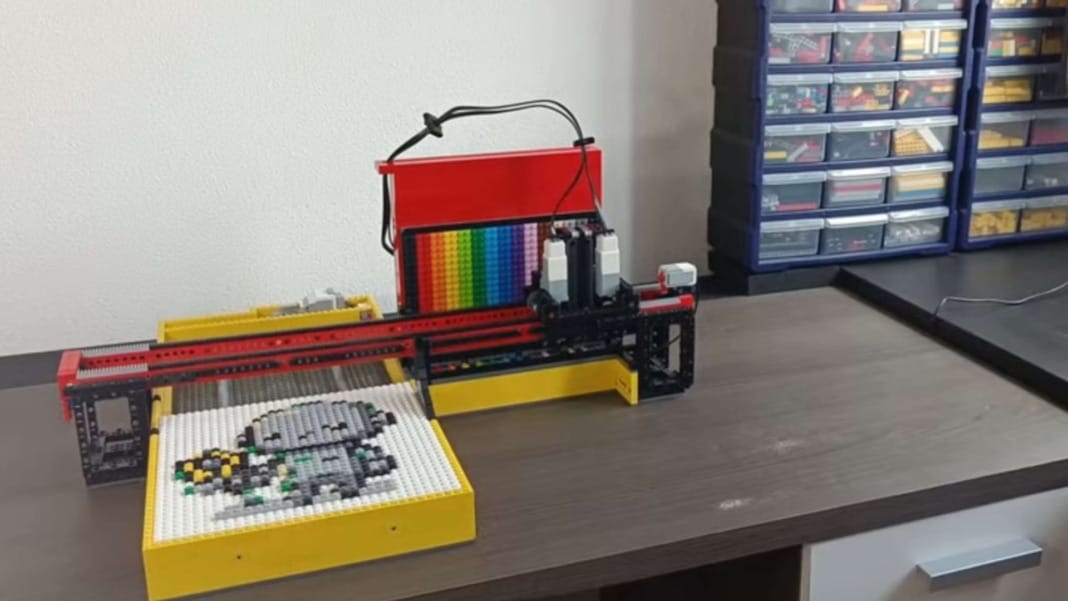A passionate YouTuber has ingeniously designed and built a Lego printer that automates the creation of intricate brick-built mosaics, similar to Lego’s art sets like da Vinci’s Mona Lisa or Hokusai’s The Great Wave. This innovative Lego printer, known as the Pixelbot 3000, is inspired by an earlier Lego printer called the Bricasso. However, it takes a significant leap forward by incorporating artificial intelligence (AI) into its operation. AI, in this context, refers to the ability of a machine to imitate intelligent human behaviour, such as recognising and interpreting images. With the Pixelbot 3000, AI is used to simplify the process of creating Lego mosaics, making it more accessible and efficient.
A leap from the Bricasso
When Jason Allemann’s Bricasso made its debut eight years ago, it was hailed as a technical marvel. The Bricasso was a Lego printer that could create intricate brick-built mosaics, similar to Lego art sets like da Vinci’s Mona Lisa or Hokusai’s The Great Wave. However, it required a complex process where mosaic designs had to be manually created, printed on paper, and then scanned by the machine’s camera. This method, although impressive, was labour-intensive and time-consuming. The Pixelbot 3000, inspired by the Bricasso, takes a significant leap forward by incorporating artificial intelligence (AI) into its operation, simplifying the process and making it more accessible and efficient.
Introducing Creative Mindstorms, a YouTube channel that has elevated this concept. By integrating custom code and AI, they have significantly streamlined the process. With the Pixelbot 3000, a simple input is all it takes to generate a Lego mosaic.
The magic of AI
The Pixelbot 3000 works by having users type in the artwork they want the printer to create. This prompt is then sent to OpenAI’s DALL-E 3, which generates a cartoon-style image at a size of 1024 x 1024 pixels. The mosaics produced by the printer are limited to a 32 x 32 Lego tile grid. However, instead of merely resizing the image, the Pixelbot 3000’s code divides the AI-generated image into a 32 x 32 grid and samples the colour of the centre pixel in each square. This method results in a high-contrast, scaled image that creates a more precise mosaic. The final step involves the AI-generated image undergoing one final pass to match each pixel’s colour to the closest available 1 x 1 Lego tile, ensuring the final mosaic is as accurate as possible.
One of the constraints of using Lego bricks as an artistic medium is the limited colour palette—Lego bricks are available in only about 70 different colours, and the Pixelbot 3000 uses just 15 of them. Additionally, the mosaics produced by the printer are limited to a 32 x 32 Lego tile grid. While this may seem restrictive, it’s important to note that the Pixelbot 3000’s code is designed to make the most of these limitations. The AI-generated image undergoes one final pass to match each pixel’s colour to the closest available 1 x 1 Lego tile, ensuring the final mosaic is as accurate as possible within these constraints.
From concept to reality
Designing, building, and programming the Pixelbot 3000 seems as demanding as assembling one of Lego’s mosaic artworks, which can consist of over 11,000 pieces. Yet the result is a fascinating fusion of technology and creativity. If you want to unwind, take 15 minutes to watch Creative Mindstorms’ video, which documents the Pixelbot 3000’s journey from a concept to a fully functional machine.
This remarkable project highlights the endless possibilities when technology and creativity intersect, offering a fresh take on traditional Lego art and paving the way for more innovative uses of AI in artistic endeavours. If you’re intrigued by the Pixelbot 3000 and want to see more AI-powered Lego projects, be sure to check out the Creative Mindstorms YouTube channel for more inspiring content.





